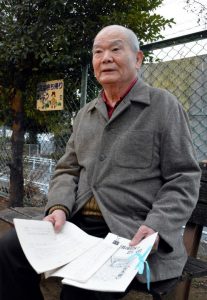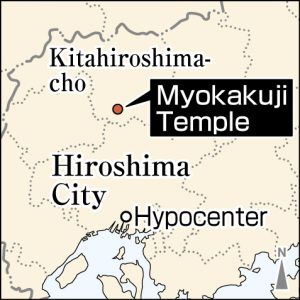Hiroshima Summit—Starting point for abolition of nuclear weapons, Part 8: A-bomb orphans
Feb. 18, 2023
Not A-bomb survivors but still victims
by Kyosuke Mizukawa, Senior Staff Writer
After Hiroshima had been selected to host the summit meeting of the G7 (Group of Seven industrialized nations), Yusuke Yoshimura, 88, a resident of Kashiwa City in Chiba Prefecture, sent a letter to Toshiyuki Mimaki, 80, chair of the Hiroshima Prefectural Confederation of A-bomb Sufferers Organizations (Hiroshima Hidankyo) who lives in the town of Kitahiroshima-cho. Mr. Yoshimura wrote, “I was also orphaned by the atomic bombing. Please stand firm for nuclear abolition.” Prior to the atomic bombing, he had been evacuated away from Hiroshima to a safer location, but five of his family members, including his father, were killed in the bombing. As a result, he ended up living with his older brothers after the war. He wrote about his expectations for the summit event as a victim of the atomic bombing and war.
Mr. Yoshimura was the youngest of seven siblings. Before the bombing, 78 years ago, he was living with his father and four brothers and sisters in the Nishijikata-cho area (now part of Hiroshima’s centrally located Naka Ward). His mother had previously died of illness and two other brothers had been conscripted into the wartime military and were stationed outside the prefecture.
Evacuating to safer location changed fate
In the spring of 1945, the Hiroshima City government began to evacuate school children to safer locations in groups, but Mr. Yoshimura, then a fifth grader at Kanzaki National School (present-day Kanzaki Elementary School), did not at first join the other students. He said, “My family thought we should die together if the time came.” Persuaded by his teacher, however, he moved to Myokakuji Temple (in present-day Kitahiroshima-cho) around the end of June, an act that ultimately changed his fate.
His father, Kanichi, then 53, sister Hatsuyo, 29, and brother Isao, 15, were at their home about 600 meters from the hypocenter and killed in the atomic bombing. His sister Shigeko, 27, had left home for work, and brother Fumio, 13, had been mobilized as a student worker. Their remains were never found.
Some of the 36 children that had been evacuated to Myokakuji Temple were picked up by family, but by the end of August more than 10 children remained. One was Mr. Yoshimura. A nearby farming family offered to adopt him. On September 8, as the adoption arrangements were underway, his two brothers came to get him after they had been demobilized from the military.
He and the younger children who remained at the temple repeated their farewells to each other as he walked down the temple’s stone steps. Everyone felt uneasy, but as an older child of the group, he put on a brave face in an effort to cheer them. “I felt as if I was deserting my younger brothers and sisters, though,” he recalled.
Remembering past and crying when summer came
Life was difficult for many years, but with the help of his two older brothers, he graduated from Hiroshima University and became a national government employee. Every year at the end of summer, he would remember how he lived with the other children at Myokakuji Temple, a recollection that brought tears to his eyes. A girl one year younger than Mr. Yoshimura had not been picked up by relatives and was instead adopted by a nearby farming family. The last two children were brought to an orphanage in the area of Hijiyama in Hiroshima at the end of November that year, a circumstance he learned about after reading an account written by a teacher in charge of the children.
The number of orphans who lost their parents in the atomic bombing is unknown, but some estimates put it at between 2,000 and 6,500. Many had been evacuated to safer locations before the bombing and were thus not considered A-bomb survivors under the Atomic Bomb Survivors Relief Law, which provides assistance for health damage caused by radiation. In that way, many orphans were left outside the scope of relief measures.
Mr. Mimaki, chair of Hiroshima Hidankyo, thought, “Many such children lost their families and went through a terribly difficult time of things. Why couldn’t the government have done anything to help them?” That situation has bothered Mr. Mimaki, who is an adherent of Myokakuji Temple and lives nearby. In 2008, in cooperation with the temple priest and others, he invited students from Kanzaki Elementary School and eight people who had been evacuated to the temple during the war and held a reunion gathering there. Mr. Mimaki and Mr. Yoshimura came to know each other at the reunion.
Mr. Mimaki now keeps Mr. Yoshimura’s letter at hand and reflects on the hopes that Mr. Yoshimura has for the Hiroshima Summit. He believes it is not only the feelings of the A-bomb survivors that the leaders should confront in Hiroshima. Also important are those who lost family members in the atomic bombings and air raids and young people who will continue to carry on the memories of war victims. Those “Hiroshima voices” represent the desire for peace and a belief that no one else should have to experience the same suffering, ideas shared across geographical regions and generations.
Precisely because the future has been made uncertain due to Russia’s invasion of Ukraine, Mr. Mimaki emphasizes, “When people in the future look back on this time, the summit must be remembered as the point that marked the beginning of change for the better.” The summit must be the starting point for creating a world without nuclear weapons or war. Based on this fervent desire, we all await the start of the summit, which will be held in three-months’ time as of March 19.
(Originally published on February 18, 2023)









